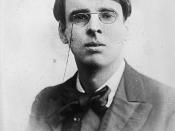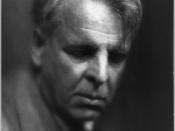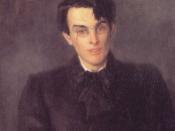Between the Celtic visions of THE WANDERINGS OF OISIN (1889) and the intellectual, often obscure poetry of the 1930s, Yeats produced a tremendous amount of works. In his early career Yeats studied William Blake's poems, Emanuel Swedenborg's writings and other visionaries. Later he expressed his disillusionment with the reality of his native country. Irish poet, dramatist and prose writer William Butler Yeats was born in Dublin on 13th June 1865 into an Irish Protestant family. His early years Yeats spent in London and Slingo, a beautiful county on the west coast of Ireland. the area was rich in both mythological and aristocratic traditions and, for both these reasons , is very frequently mentioned in Yeast's poems.
His father, John Butler Yeats, a clergyman's son, was a lawyer turned to an Irish Pre-Raphaelite painter. He was passionately involved in London's artistic life in the 1870s as a supporter of the primary importance of pure emotion in art and an opponent of intellectual abstraction.
Yeats's views on poetry and art were by no means unique, of course, deriving a great deal in particular from the "Pre-Raphaelite" group. He was already being encouraged to think of himself as a writer by his father, and the next nine years gave him a fine opportunity to soak his imagination in the Irish folk-lore which was to provide the impetus for much of his early poetry.
In 1885 Yeats moved from Dublin High school to the Dublin School of Arts. In "Autobiographies" Yeats speaks of his youthful conviction:
"only beautiful things should be painted , and
that only ancient things and the stuff of dreams
were beautiful"
Shortly after joining the School of Art yeats also began to explore mysticism and the occult , encouraged by the famous , Madame Blavatsky , an interest which...


